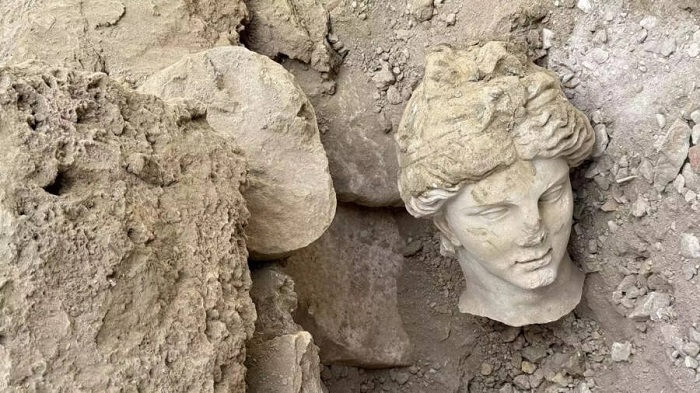Hygieia was the Greek goddess of health and cleanliness, and she lends her name to the word “hygiene.”

On May 20, 2024, archaeologist Dr. Celal Şimşek and his team discovered a statue head of Hygieia, the Greek goddess of health, while carrying out excavations in the ancient city of Laodicea on the Lycus, Türkiye.
The statue is estimated to be 2,100 years old, and it may have been erected at a healing center within the city. Now, Dr. Şimşek and his team are hoping to unearth the rest of the statue for further study.

Excavations Reveal The Statue Head Of Hygieia
Excavations in Laodicea began in 2003, and in the past two decades, archaeologists have unearthed countless ruins and artifacts from the ancient world. Earlier this year, a statue of Asclepius, the Greek god of medicine, was discovered. Then, on May 20, Dr. Celal Şimşek from the Pamukkale University Archaeology Department uncovered a 2,100-year-old statue of Asclepius’ daughter Hygieia, the goddess of health and cleanliness.

Dr. Şimşek shared the good news on his X account, writing: “Goddess Hygieia meeting the Sun and us after 2,100 years in Laodikeia.”
According to ArtDog Istanbul, Dr. Şimşek explained that both the statues of Asclepius and Hygieia “were created in the late Hellenistic – early Augustus Period in the classical style. These statues of the god and goddess of health highlight the presence of the Herophileion medical school in Laodicea and the ancient writer Strabo, one of the notable doctors trained there. The statues exhibit very fine craftsmanship and high artistic quality.”
Hygieia’s name inspired the word “hygiene.” Many depictions of her show her holding a snake, the symbol of her father. The goddess’s statues are commonly found near ancient healing centers and temples. Şimşek and his team now hope to find the body of the statue within the ruins of Laodicea.

The Importance Of Laodicea In Ancient History
The ancient city of Laodicea dates back to 5500 B.C.E. Located on the south side of the Lycus River in southwestern Türkiye, the city played a key role in the ancient Mediterranean world. It was even mentioned in the Bible.
Antiochus II founded Laodicea between 263 and 261 B.C.E. and named it after his wife. Its advantageous geographic location, coupled with connections to trade routes, transformed it into a bustling city by the 1st century B.C.E.

At its peak, the city boasted many impressive constructions, including a large stadium, theaters, public gathering places, baths, temples, fountains, and more.
However, Laodicea also frequently experienced devastating earthquakes. The worst occurred during the reign of Emperor Nero in 60 C.E. and resulted in the destruction of the entire city.
Despite these disasters, Laodicea always rebuilt and maintained its status as an important center for trade. It wasn’t until the 7th century C.E. that inhabitants abandoned the city after yet another serious earthquake and an increase in Arab raids.
Today, Laodicea is on Türkiye’s Tentative List of World Heritage Sites. Findings like those of Dr. Şimşek only reinforce the need to continue excavations to further study the city’s historical importance in antiquity.
After reading about the statue head of the Greek goddess Hygieia discovered in Türkiye, dive into the story of Hades and Persephone in Greek mythology. Then, read about the enigmatic Sea Peoples and how they brought a swift end to the Bronze Age.

